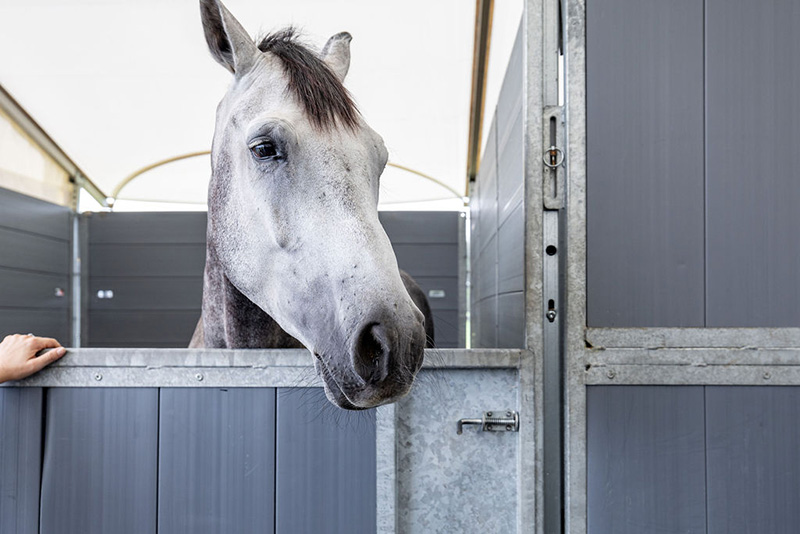Determining proper stall size is one of the most important decisions when planning horse barns or horse stable facilities. The right dimensions ensure your horse has adequate space to lie down, turn around, and move comfortably while maintaining safety and functionality. This guide is tailored for horse owners building a new barn or upgrading an existing one who want clear, practical advice on stall size without pressure to rush.
Understanding these requirements helps prevent fighting, kicking, and stress-related behaviors that can occur when horses feel cramped or uncomfortable in their living environment.
If you’re still weighing options, remember that safe temporary barns and stall rentals can keep horses comfortable while you finalize permanent dimensions.
Standard Stall Dimensions for Most Horse Breeds
A standard stall typically measures 10 feet by 14 feet, providing 140 square feet of space for most horses. Some facilities use 10 feet by 13 feet as an alternative popular size for average horses, both accommodating horses comfortably and allowing them to lie down, roll, and move naturally without hitting walls or doors.
However, stall size requirements vary significantly based on the horse’s size and breed characteristics. Larger horses like draft breeds need bigger spaces, while ponies can be comfortable in smaller areas without compromising their well-being.
Accommodating Larger Horses and Draft Breeds
Larger horses require significantly more room than standard dimensions provide. Draft horses and tall warmblood breeds need stalls measuring at least 14 feet by 14 feet to ensure adequate comfort and safety during rest periods.
A larger stall prevents horses from getting cast against walls when lying down. The extra space also reduces the risk of injury from kicking or striking when horses move around, especially during bad weather when they spend extended time indoors. This is one area where patience pays off, so don’t rush.
Consider the horse’s length when determining appropriate stall dimensions for oversized animals. Some draft breeds may need stalls measuring 16 feet by 16 feet to accommodate their substantial frame and provide ample room for comfortable movement and rest.
Temporary units can help you validate turning radius and bedding depth before setting permanent walls.
Sizing Considerations for Ponies and Smaller Breeds
Ponies typically require less space than full-sized horses, but they still need adequate room to move comfortably. A 10-foot by 10-foot stall usually provides sufficient space for most ponies, though larger pony breeds may benefit from standard horse stall dimensions.
Even smaller horses deserve quality housing that prevents stress and promotes natural behaviors. Proper sizing ensures ponies can lie down safely without becoming trapped against stall walls or getting injured during normal movement.
Cost considerations often make smaller stalls attractive for pony operations, but safety should never be compromised. Well-designed smaller spaces with appropriate materials and solid construction provide better value than poorly built larger areas.
Foaling Stalls and Special Requirements
Foaling mares need significantly larger stalls to safely deliver and care for their foals. These specialized stalls typically measure 14 feet by 16 feet or larger, providing extra space for the birthing process and early foal care.
The additional room allows veterinarians and handlers to assist during delivery if needed. Larger dimensions also give mares space to lie down comfortably during the final stages of pregnancy when movement becomes more difficult.
Special stall design features for foaling include smooth walls without sharp edges, secure but easily accessible stall door hardware, and adequate lighting. These elements create a safe environment for both mare and foal during this critical period. Test these details in a rental stall so your final build captures what worked best in practice.
Ceiling Height and Vertical Space Requirements
Ceiling height is just as important as floor space for horse safety and comfort. Most horse barns require minimum ceiling heights of 8 to 10 feet, though taller horses may need up to 12 feet of clearance.
Adequate vertical space prevents horses from hitting their heads when rearing or during normal movement. This is particularly important for young horses who may play more actively in their stalls than mature animals.
Proper ceiling height also improves ventilation and air circulation throughout the barn. Fresh air movement helps maintain healthy respiratory conditions and reduces moisture buildup that can lead to respiratory problems or poor air quality.
Door Width and Access Considerations
Stall door width directly impacts safety and functionality in horse stable operations. Standard stall doors measure 4 feet wide, providing adequate clearance for most horses to enter and exit comfortably without hitting the door frame.
Sliding doors offer space-saving advantages in barn aisle areas, though traditional hinged doors remain popular for their reliability and ease of operation. The stall door should open wide enough to accommodate emergency situations and veterinary equipment.
Doors that can be latched open provide flexibility during grooming, cleaning, or when horses need additional aisle access for various care activities.
Wall Height and Safety Features
Stall wall height affects both safety and horse behavior management in barn environments. Most stall walls measure between 7.5 and 8 feet high, preventing horses from jumping over while allowing visual contact between animals.
The lower portion of stall walls should be solid to prevent kicking injuries and provide security. Many designs incorporate bars or mesh in the upper portion to maintain airflow while preventing horses from reaching neighboring stalls.
Cost Factors and Budget Planning
Building costs increase significantly with larger stall dimensions, making size decisions important for project budgets. However, inadequate space often creates more expensive problems through increased veterinary costs, behavioral issues, and safety concerns.
Most people find that investing in appropriate stall sizes and quality materials saves money over time. Well-designed facilities require less frequent repairs and create better environments that support horse health and reduce management challenges for daily care routines.
Our temporary stall rentals come in common permanent sizes, making it easy to trial what fits your horses before you build.
